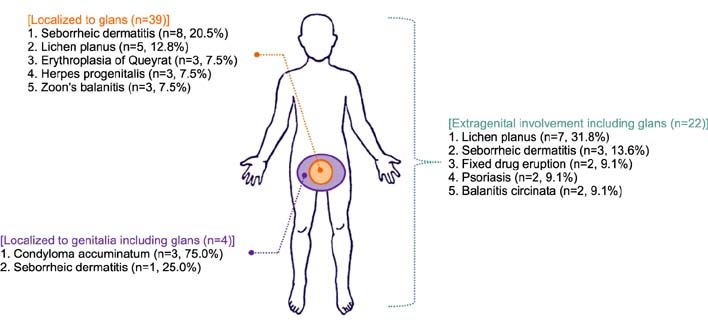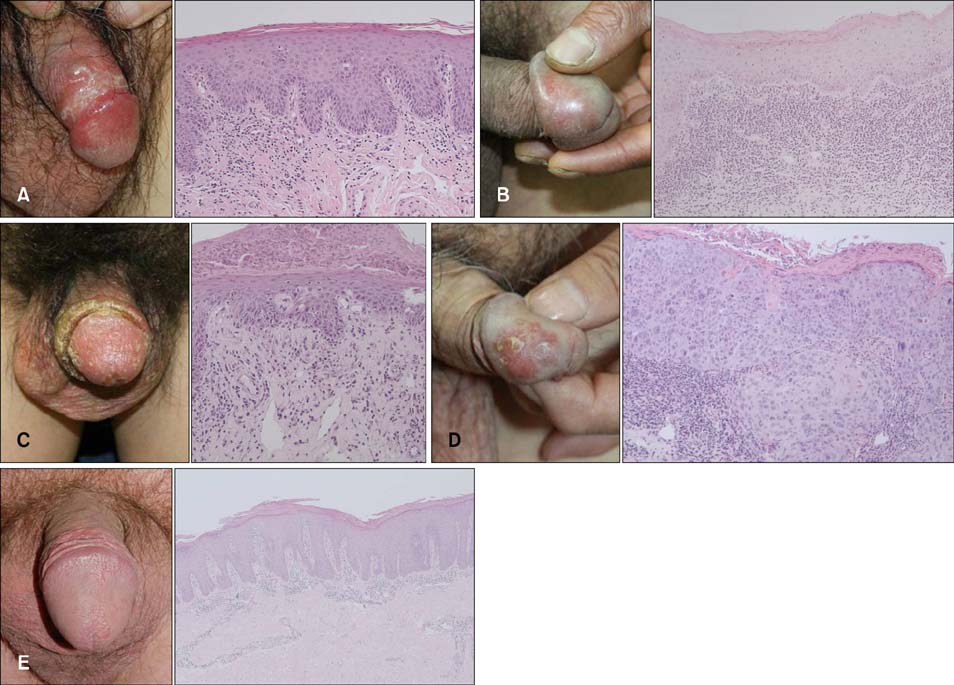Ann Dermatol.
2016 Feb;28(1):40-44. 10.5021/ad.2016.28.1.40.
Dermatoses of the Glans Penis in Korea: A 10-Year Single Center Experience
- Affiliations
-
- 1Department of Dermatology, Pusan National University School of Medicine, Busan, Korea. drkmp@hanmail.net
- 2Medical Research Institute, Pusan National University Hospital, Busan, Korea.
- KMID: 2429480
- DOI: http://doi.org/10.5021/ad.2016.28.1.40
Abstract
- BACKGROUND
A variety of infectious, inflammatory, and neoplastic dermatoses can develop on the glans penis, and definitive diagnosis in such cases may be difficult owing to their non-specific symptoms and clinical appearance. Furthermore, data on dermatoses of the glans penis in Korea are limited.
OBJECTIVE
In the present study, we aimed to determine the prevalence of dermatoses of the glans penis in Korea and provide clinical data to assist in making an accurate diagnosis.
METHODS
We retrospectively reviewed the medical records, clinical photographs, and histologic slides of 65 patients with dermatoses of the glans penis that visited the Pusan National University Hospital between January 2004 and August 2013.
RESULTS
Twenty-six types of dermatoses were identified: inflammatory dermatosis was the most common (38/65, 58.5%), followed by infectious (13/65, 20.0%), neoplastic (10/65, 15.4%), and other dermatoses (4/65, 6.2%). The most common dermatosis of the glans penis was seborrheic dermatitis, followed by lichen planus, herpes progenitalis, condyloma accuminatum, erythroplasia of Queyrat, Zoon's balanitis, and psoriasis. In the topographic analysis, the most common type of dermatosis was dermatoses that localized to the glans penis (39/65, 60.0%), followed by dermatoses involving the extra-genitalia and glans penis (22/65, 33.9%), and the genitalia (glans penis plus other genital areas) (4/65, 6.2%).
CONCLUSION
This study shows the usefulness of a topographic approach in the diagnosis of dermatoses of the glans penis in Korea. The findings could be used as baseline data for establishing an accurate diagnosis in Koreans.
Keyword
MeSH Terms
Figure
Reference
-
1. English JC 3rd, Laws RA, Keough GC, Wilde JL, Foley JP, Elston DM. Dermatoses of the glans penis and prepuce. J Am Acad Dermatol. 1997; 37:1–24. quiz 25-6.
Article2. Singh S, Bunker C. Male genital dermatoses in old age. Age Ageing. 2008; 37:500–504.
Article3. Parker SW, Stewart AJ, Wren MN, Gollow MM, Straton JA. Circumcision and sexually transmissible disease. Med J Aust. 1983; 2:288–290.
Article4. Mallon E, Hawkins D, Dinneen M, Francics N, Fearfield L, Newson R, et al. Circumcision and genital dermatoses. Arch Dermatol. 2000; 136:350–354.
Article5. Kim D, Koo SA, Pang MG. Decline in male circumcision in South Korea. BMC Public Health. 2012; 12:1067.
Article6. Hillman RJ, Walker MM, Harris JR, Taylor-Robinson D. Penile dermatoses: a clinical and histopathological study. Genitourin Med. 1992; 68:166–169.
Article7. Eichmann AR. Dermatoses of the male genital area. Dermatology. 2005; 210:150–156.
Article8. Buechner SA. Common skin disorders of the penis. BJU Int. 2002; 90:498–506.
Article9. Karthikeyan K, Jeevankumar B, Thappa DM. Bullous lichen planus of the glans penis. Dermatol Online J. 2003; 9:31.
Article10. Alinovi A, Barella PA, Benoldi D. Erosive lichen planus involving the glans penis alone. Int J Dermatol. 1983; 22:37–38.
Article
- Full Text Links
- Actions
-
Cited
- CITED
-
- Close
- Share
- Similar articles
-
- A Case of Apocrine Hidrocystoma of the Glans Penis
- A Case of Milium Occurring on the Glans Penis
- Lichen Sclerosus et Atrophicus of the Glans and Prepuce of the Penis - A Case Report -
- Postcircumcision Color Change of the Glans Penis Associated with a 0.2% Lidocaine Dorsal Nerve Block
- A Prominently Large Glans penis as a Possible sign of Benign Prostatic Hyperplasia



